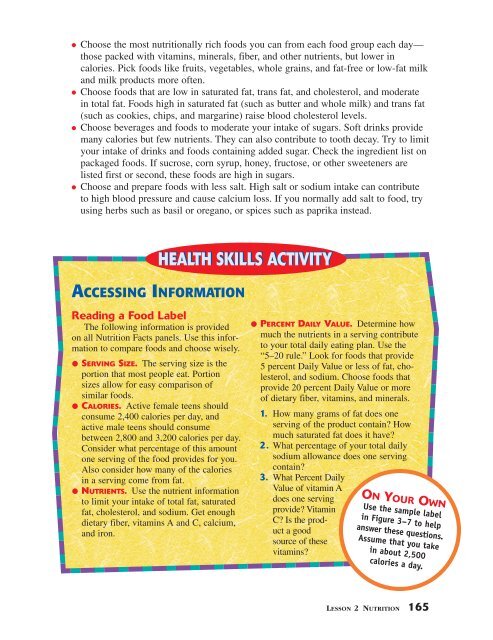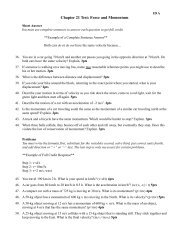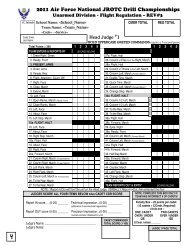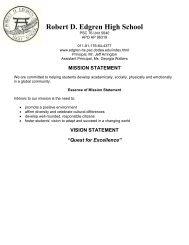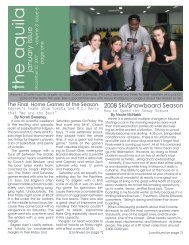AFJROTC Student Workbook CH03_Lesson_2 - Edgren High ...
AFJROTC Student Workbook CH03_Lesson_2 - Edgren High ...
AFJROTC Student Workbook CH03_Lesson_2 - Edgren High ...
You also want an ePaper? Increase the reach of your titles
YUMPU automatically turns print PDFs into web optimized ePapers that Google loves.
<strong>CH03</strong>_LE1 6/28/05 4:19 PM Page 165<br />
• Choose the most nutritionally rich foods you can from each food group each day—<br />
those packed with vitamins, minerals, fiber, and other nutrients, but lower in<br />
calories. Pick foods like fruits, vegetables, whole grains, and fat-free or low-fat milk<br />
and milk products more often.<br />
•<br />
Choose foods that are low in saturated fat, trans fat, and cholesterol, and moderate<br />
in total fat. Foods high in saturated fat (such as butter and whole milk) and trans fat<br />
(such as cookies, chips, and margarine) raise blood cholesterol levels.<br />
•<br />
Choose beverages and foods to moderate your intake of sugars. Soft drinks provide<br />
many calories but few nutrients. They can also contribute to tooth decay. Try to limit<br />
your intake of drinks and foods containing added sugar. Check the ingredient list on<br />
packaged foods. If sucrose, corn syrup, honey, fructose, or other sweeteners are<br />
listed first or second, these foods are high in sugars.<br />
•<br />
Choose and prepare foods with less salt. <strong>High</strong> salt or sodium intake can contribute<br />
to high blood pressure and cause calcium loss. If you normally add salt to food, try<br />
using herbs such as basil or oregano, or spices such as paprika instead.<br />
HEALTH SKILLS ACTIVITY<br />
HEALTH SKILLS ACTIVITY<br />
ACCESSING INFORMATION<br />
Reading a Food Label<br />
The following information is provided<br />
on all Nutrition Facts panels. Use this information<br />
to compare foods and choose wisely.<br />
SERVING<br />
•<br />
SIZE. The serving size is the<br />
portion that most people eat. Portion<br />
sizes allow for easy comparison of<br />
similar foods.<br />
•<br />
CALORIES. Active female teens should<br />
consume 2,400 calories per day, and<br />
active male teens should consume<br />
between 2,800 and 3,200 calories per day.<br />
Consider what percentage of this amount<br />
one serving of the food provides for you.<br />
Also consider how many of the calories<br />
in a serving come from fat.<br />
•<br />
NUTRIENTS. Use the nutrient information<br />
to limit your intake of total fat, saturated<br />
fat, cholesterol, and sodium. Get enough<br />
dietary fiber, vitamins A and C, calcium,<br />
and iron.<br />
PERCENT DAILY<br />
•<br />
VALUE. Determine how<br />
much the nutrients in a serving contribute<br />
to your total daily eating plan. Use the<br />
“5–20 rule.” Look for foods that provide<br />
5 percent Daily Value or less of fat, cholesterol,<br />
and sodium. Choose foods that<br />
provide 20 percent Daily Value or more<br />
of dietary fiber, vitamins, and minerals.<br />
1. How many grams of fat does one<br />
serving of the product contain How<br />
much saturated fat does it have<br />
2. What percentage of your total daily<br />
sodium allowance does one serving<br />
contain<br />
3. What Percent Daily<br />
Value of vitamin A<br />
does one serving<br />
provide Vitamin<br />
C Is the product<br />
a good<br />
source of these<br />
vitamins<br />
ON YOUR OWN<br />
Use the sample label<br />
in Figure 3–7 to help<br />
answer these questions.<br />
Assume that you take<br />
in about 2,500<br />
calories a day.<br />
LESSON 2 NUTRITION 165


